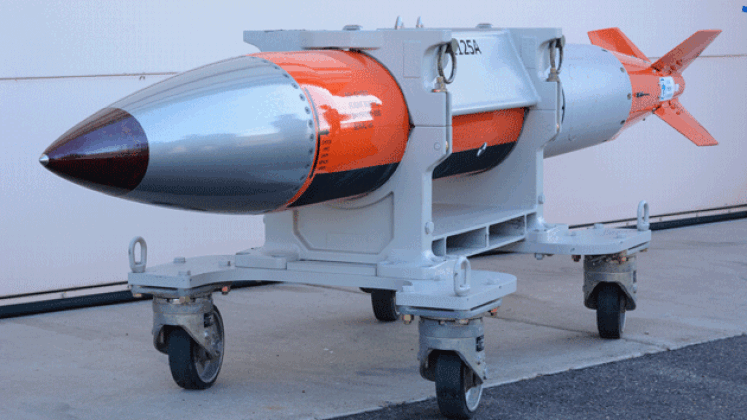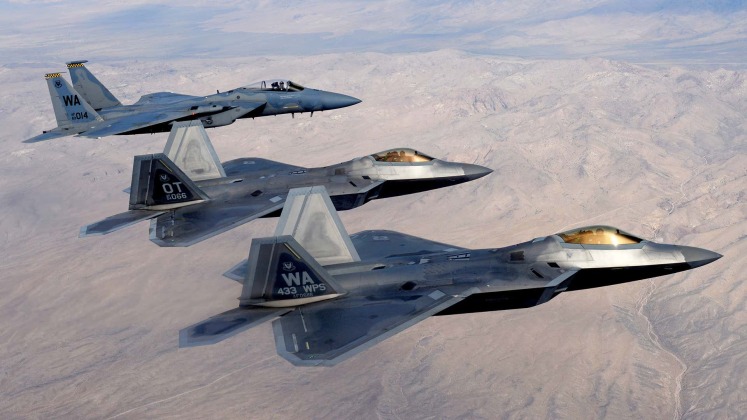News
When Lockheed Martin Pitched the F-22 as a Nuclear Strike Fighter: Why It Was Never a Viable Proposition
The F-22 Raptor joined the U.S. Air Force in December 2005 as the world’s first fifth generation fighter aircraft, with the defunding of the rival Soviet MiG 1.42 program after the state’s disintegration in 1991 ensuring that the new American aircraft would have no near peer rivals in performance for over a decade. Despite the revolutionary capabilities of its F119 engines and its radar cross section reducing stealth airframe, deep cuts to the F-22 program in the 1990s gained strong support on both Capitol Hill and in the Pentagon due to the fighter’s extreme costs, with both production and operational costs being well over double initial projections. This made the aircraft highly unaffordable even compared to its already very expensive predecessor the F-15, which much like the F-22 was a heavyweight twin engine aircraft designed for high end air superiority missions. Wide ranging issues with the F-22, ranging from problematic computer architecture and obsolete avionics to detrimental effects on pilots’ lungs and extreme maintenance requirements, further strengthened calls to make deep cuts to the program. The Raptor also remained by far the least versatile fighter class to enter service anywhere in the world since the 1980s, with the aircraft initially unable to launch air to surface or anti shipping strikes. Although belatedly gaining the former capability, it still suffered very serious limitations due to its inability to accommodate anything other than very low diameter gravity bombs in its weapons bays.
As a reduction of F-22 production to a fraction of its previously planned length appeared increasingly likely in the 2000s, advocates of a larger production run made multiple efforts to pitch modifications to the aircraft which could increase its usefulness to the Air Force. One of the most notable was an effort by Lockheed Martin chief executive Robert Stevens to propose using the Raptor as a nuclear strike aircraft, which would allow it to contribute to American strategic deterrence capabilities alongside its role as an air superiority fighter. “In my mind’s eye, there is almost a singular alternative available to a strategic nuclear deterrent and that would lead us to … the F-22,” he stated at the Reuters Aerospace and Defence Summit in Washington in December 2008. He stated that while F-22 production lines would begin to close in late March 2009, and reopening production later on would be “prohibitively expensive,” fielding Raptors as nuclear strike aircraft could mitigate this issue by allowing for a greater production run. “The airplane has the characteristics of being able to penetrate the most significant area-denial capabilities that exist today,” he stated, which was an ability that could “dissuade an adversary without the application of nuclear weapons and I think that acts in a deterrence fashion without the necessity of bringing nuclear weapons into the discussion.” He added that another multiyear purchase of F-22s would drive unit costs down.

The viability of further F-22 acquisitions and use of the aircraft for nuclear strike roles was highly questionable at the time, and appears not to have been seriously considered by the Pentagon. Thomas Christie, who served as the Pentagon’s chief weapons tester for four years until February 2005, dismissed calls to use the F-22 as a nuclear strike aircraft as “amazing” and “grasping at straws.” A primary issue remained the F-22’s shallow weapons bay which prevented it from internally carrying beyond visual range air to surface weaponry or larger diameter gravity bombs – including the B61 series of bombs which were deployed by other classes of American fighters. While fighters from previous generations had consistently had longer ranges than their immediate predecessors, the F-22’s range was significantly shorter than that of the preceding F-15 – and even that of the much lighter single engine F-35 fighter which would enter service a decade later. Placing its range in perspective, the Chinese J-20 and Russian Su-57 fifth generation fighters both had over double the combat radii of the F-22 with the very short reach of the American fighter seriously limiting its usefulness as a carrier of nuclear payloads even if its weapons bay could accommodate them.

Ultimately wide ranging issues with the F-22 not only cut production to less than one quarter of initial projections, but also led the Air Force to seek from 2022 to begin retiring airframes that had flown for less than one quarter of their service lives due to their limited usefulness to the fleet and very high operational costs. The F-22 saw orders to terminate production given less than four years after the fighter class began to enter service, and thus failed to provide a viable successor to the F-15. The F-15 not only continues to carry American nuclear weapons, but also continues to receive orders from the Pentagon while F-22s are being retired. Although the very limited types of weapons the F-22 was able to carry was a leading shortcoming of the design, it was not the primary factor which led to a cutting of production and to the class’ early retirement, with excessive operational costs and maintenance needs, resulting low availability rates, and serious performance and reliability issues, making continued acquisitions appear highly unattractive.












